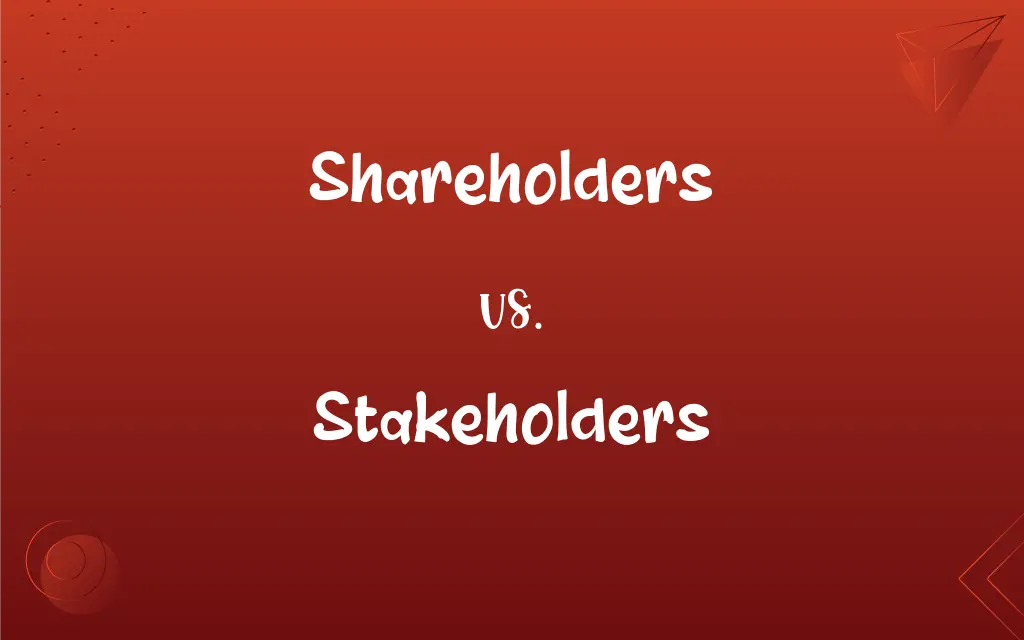Shareholders vs. Stakeholders: What's the Difference?
Edited by Janet White || By Harlon Moss || Updated on October 16, 2023
Shareholders are individuals who own shares in a company, while stakeholders have an interest or concern in a company's activities.

Key Differences
Shareholders specifically refer to individuals or entities that own shares in a corporation. They possess a financial interest in the company and benefit from its profits, primarily through dividends and the appreciation of stock value. On the other hand, stakeholders encompass a broader category of individuals or groups who might be affected by a company's activities, whether they own shares or not.
Shareholders, by virtue of their investment, have the right to vote on certain company decisions and can exert influence on its management and strategic direction. Stakeholders, which could include employees, customers, suppliers, and even the local community, might not have the same decision-making power as shareholders but have a vested interest in how the company operates and performs.
For shareholders, their primary concern often revolves around the financial performance of the company and the return on their investment. Stakeholders, however, have diverse interests ranging from job security for employees, quality products for customers, timely payments for suppliers, or environmental concerns for the community.
While shareholders are technically a subset of stakeholders (because they too are affected by the company's activities), not all stakeholders are shareholders. An employee, for instance, might not own any shares in the company they work for but is deeply affected by its decisions and financial health.
The relationship between a company and its shareholders is primarily financial, while its relationship with stakeholders can be multifaceted, ranging from financial to social and environmental.
ADVERTISEMENT
Comparison Chart
Definition
Owners of shares in a company.
Anyone affected by a company's activities.
Primary Concern
Financial performance and ROI.
Diverse interests, from finance to social concerns.
Influence
Voting rights on company decisions.
Varies, but generally less direct than shareholders.
Relationship with Company
Primarily financial.
Multifaceted, from financial to environmental.
Scope
Subset of stakeholders.
Includes shareholders and others affected by company.
ADVERTISEMENT
Shareholders and Stakeholders Definitions
Shareholders
Shareholders can influence company decisions through voting.
The shareholders rejected the CEO's compensation package.
Stakeholders
Stakeholders include anyone with an interest in a company's actions.
The company met with stakeholders to discuss environmental policies.
Shareholders
Shareholders are individuals or institutions owning shares in a company.
The shareholders voted on the new merger proposal.
Stakeholders
Stakeholders can be internal or external to a company.
Employees and customers are both key stakeholders.
Shareholders
Shareholders have a financial stake in a corporation's success.
As shareholders, they were concerned about the quarterly profits.
Stakeholders
Stakeholders have varied interests, from profits to social impacts.
The stakeholders debated over the new factory's location.
Shareholders
Shareholders earn dividends based on the company's profits.
The shareholders were pleased with the annual dividend distribution.
Stakeholders
Stakeholders might not own shares but are affected by the company.
The local community stakeholders were concerned about pollution.
Shareholders
Shareholders' primary focus is on return on investment (ROI).
Shareholders expect the company to maximize their ROI.
Stakeholders
Stakeholders can influence a company's reputation and operations.
The stakeholders' protests led to a change in company policy.
Shareholders
One that owns a share or shares of a company or investment fund. Also called shareowner.
Stakeholders
One who has a share or an interest, as in an enterprise.
Shareholders
Plural of shareholder
Stakeholders
One who holds the bets in a game or contest.
Stakeholders
Plural of stakeholder
FAQs
What is the main concern of shareholders?
Shareholders typically focus on the financial performance of the company and ROI.
Are all shareholders stakeholders?
Yes, shareholders are a subset of stakeholders because they are affected by the company's activities.
Who are stakeholders?
Stakeholders are any individuals or groups affected by a company's activities.
Are all stakeholders shareholders?
No, not all stakeholders own shares in the company.
What's the difference in the relationship of a company with shareholders vs. stakeholders?
With shareholders, it's primarily financial, while with stakeholders, it can range from financial to social and environmental.
Do stakeholders get financial returns like shareholders?
Not typically. While shareholders receive dividends, stakeholders' returns can be non-financial, like job security or environmental improvements.
Who are shareholders?
Shareholders are individuals or institutions that own shares in a company.
Why are stakeholders important?
Stakeholders influence and are influenced by a company's decisions, operations, and reputation.
Can a customer be a stakeholder?
Yes, customers are stakeholders as they have an interest in the company's products and services.
Do shareholders always have the final say in company decisions?
No, while shareholders have voting rights, some decisions might be reserved for the company's board or management.
How do companies balance shareholder and stakeholder interests?
Companies often aim for a balance through good corporate governance, stakeholder engagement, and strategic planning.
Why is it important for a company to consider stakeholders?
Considering stakeholders can lead to better decision-making, improved reputation, and sustainable growth.
What is the primary return for shareholders?
Shareholders primarily benefit from dividends and the appreciation of stock value.
Are shareholders always the most influential stakeholders?
Not always. Influence can vary based on the situation and the specific stakeholder group in question.
What rights do shareholders have?
Shareholders have rights like voting on company decisions, receiving dividends, and more, depending on their share type.
How do stakeholders influence a company?
Stakeholders can influence a company through feedback, protests, advocacy, purchasing decisions, and more.
Can an employee be both a shareholder and a stakeholder?
Yes, an employee can be a shareholder if they own shares and is always a stakeholder due to their vested interest in the company.
Do stakeholders always have a say in company decisions?
Not always. While some stakeholders might have a direct influence, others may have a more indirect impact.
Can shareholders sell their shares?
Yes, shareholders can sell their shares in the stock market or through private transactions, depending on the type of company.
Can a community be a stakeholder?
Yes, communities can be stakeholders if a company's activities impact them.
About Author
Written by
Harlon MossHarlon is a seasoned quality moderator and accomplished content writer for Difference Wiki. An alumnus of the prestigious University of California, he earned his degree in Computer Science. Leveraging his academic background, Harlon brings a meticulous and informed perspective to his work, ensuring content accuracy and excellence.
Edited by
Janet WhiteJanet White has been an esteemed writer and blogger for Difference Wiki. Holding a Master's degree in Science and Medical Journalism from the prestigious Boston University, she has consistently demonstrated her expertise and passion for her field. When she's not immersed in her work, Janet relishes her time exercising, delving into a good book, and cherishing moments with friends and family.































































